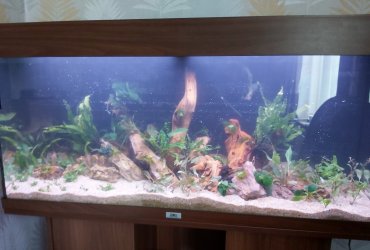Slaphppy7 has already given some good information and that linked thread for fishless cycling is definitely one to follow as I do not believe you have enough live plants to attempt a silent cycle anyway.
But will try to answer your other questions in the meantime -
1. do i leave on the light and if so for how long
2. do i need to add any ammonia (i bought dr tims ammonia chloride solution as i was intending to do a fishless cycle, but now trying a silent one)
3. how often do i need to test the water
4. when do i need to do a water change
1 - For the duration of fishless cycle, you do not need to leave the light on if you do not wish to. Lighting on or off does not affect bacteria growth of fishless cycle at all.
But for the benefit of your plants that you have at the moment which looks like mostly cryptocorynes which are low tech plants, means they not do require much light but might be worth leaving light on 7-8 hours a day to help establish plant growth, a plug in timer for the lights would be of great benefit for this as help maintain lighting routine for plants and livestock when you do eventually get them.
One other thing, cryptocornes are heavy root feeders, a good tip is to have some decent root ferts planted into the substrate near their roots every once in a while would help them grow nicely.
2. Follow the fishless cycle thread that was linked earlier for ammonia dosages and how often to dose etc.
3. To start with, test the water every 2-3 days or so just to see if you have ammonia and nitrite numbers, these should grow steadily until it peaks and then a rapid drop should occur once near the end of the cycle, will take a while before you'll see any drops in ammonia and nitrite numbers though.
4. Do NOT do any water changes whilst the fishless cycle is ongoing, doing a water change may disrupt the cycle which basically means you may be restarting the cycle process every time you do large water changes, could even stall the cycle whci is worst case scenario.
Only do water change once the fishless cycle has been completed fully and successfully, then do a large a water change as you can, this gives fresh water and to remove any nitrates for the new livestock when you are ready to add them. Of course not forgetting to dechlorinate the water beforehand.
Once livestock has been added and tank running nicely, once weekly water changes of around 50% minumum (around 70-75% is best imho) as this helps to remove any containments and nitrates as well as removing as much debris and poop from the water coloumn as possible for the livestock.
Temperature matching (one or two degrees cooler is fine but definately not a huge drop or rise in temperature as this could cause the livestock to go into shock, not nice to see as I have made this mistake once sadly when I was a newbie) and adding dechlorinator whilst doing water change is good fishkeeping practice.



